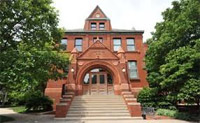Architecture, College of

Masters in Architecture Program: Theses
First Advisor
Steven Hardy
Date of this Version
Spring 5-15-2023
Document Type
Thesis
Abstract
Architecture today has responded to the typification of people we saw in the modernist era. While sectors like workplace, healthcare, and residential have responded to the changing needs of people and vast amount of differences educational architecture has been left behind as schools built in the 70’s continue to impact our students today and fail to serve each students differing needs. Schools have become architecture that must serve multiple generations. With the average age of schools rising to 44 years old we must consider how schools transverse how education is taught and learned today as well as consider how that school may be used in 50 years. According to the dept. of education early 15% of all students are diagnosed with a neurodiverse condition while in their K-12 education. Although there is speculation that the numbers of students who are neurodiverse are closer to 25%. Neurodiversity describes the idea that people experience and interact with the world around them in many ways; there is no one “right” way of thinking, learning, and behaving. While neurodiversity is the idea everyone’s brain is different it have recently been used to describe a range of neurological conditions. This range includes people with Autism, ADHD, Anxiety, Trauma, Dyslexia, and many more. These conditions are becoming more relevant within schools today as more and more students are being diagnosed. Schools design today needs spaces for neurodiverse students because by addressing environments that neurodiverse students are in using today’s knowledge of teaching and learning styles, we are improving the learning environment for all students. Neurodiverse students experience the school environment differently than neurotypical students, but schools have been designed for the average which we have coined as neurotypical, but not every “neurotypical” student is complimented by the traditional style, rather someone may be considered neurotypical but needs environments more closely related to students with ADHD or Autism. Understanding the discrepancy between the design of educational spaces and how the diverse student population learn in those spaces, How can educational spaces designed for neurodiverse students make an inclusive school environment for all students?


Comments
A design thesis Presented to the Faculty of The College of Architecture at the University of Nebraska In Partial Fulfillment of Requirements For the Degree of Master of Architecture, Major: Architecture, Under the Supervision of Professor Steven Hardy. Lincoln, Nebraska: May 2023
Copyright © 2022 Dominic Paquet